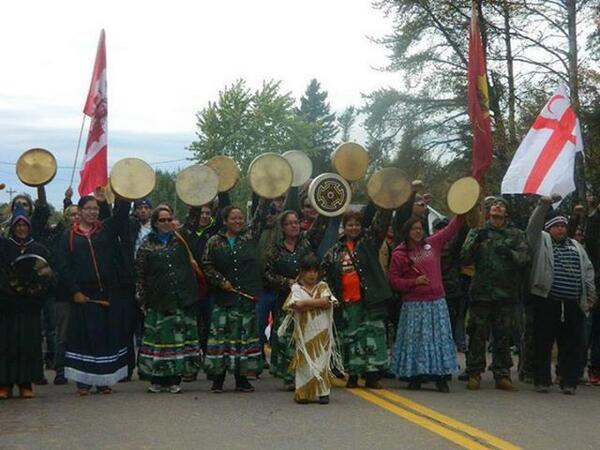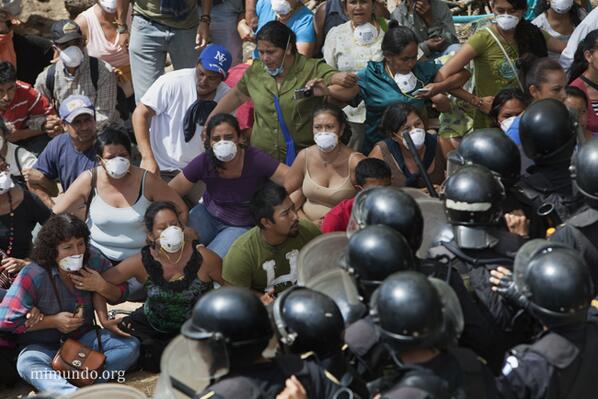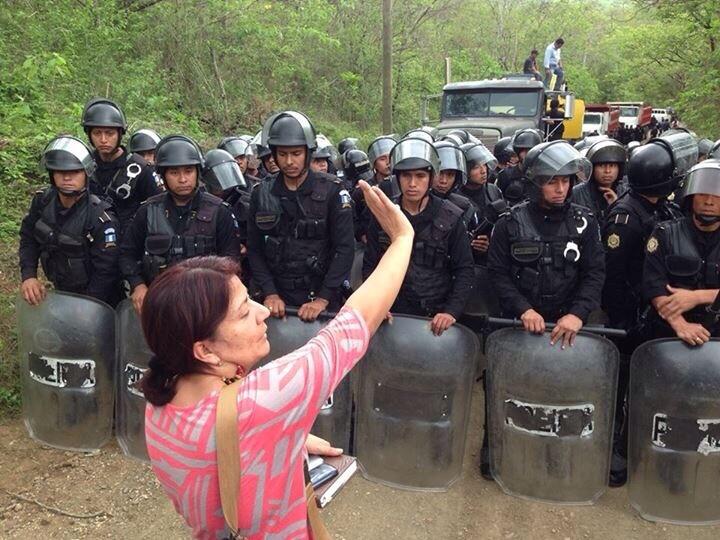The resistance of women, especially Indigenous women, is key to fighting for alternatives to capitalism and colonialism.
In their movements, women not only fight against gendered injustices, but also demand wider societal transformation to a system that in a system that doesn’t work for them as women – even though as a system it is working exactly how it’s supposed to. That is, the inequality and commodification that drives the system exploits woman (as reproductive laborers) to enable all other labor within capitalism, keeping women in a disadvantaged position. At the same time, women’s participation in social struggle is also a way of asserting and vocalizing their own worth in a system that doesn’t value and seeks to eradicate them.
This devaluation results in violence against women that is not a matter of isolated incidents or individual “bad apples.” Instead, violence against women, especially Indigenous women and women of color, is a structural component of the capitalist, colonial state.
As Costan Rican feminist journalist and human rights activist Maria Suarez Toro told teleSUR, “Violence against women is and remains a cornerstone for all other kinds of violence used to subjugate.” For Suarez Toro, normalized inequality and gendered experience, maintained through various forms of violence, are the driving force of capitalism.
In Guatemala, state-sponsored femicide and mass rape inflicted on more than 100,000 women were a strategic part of suppressing revolutionary movements during the 36-year civil war, and the majority of victims were Indigenous women. With an ongoing crisis of gendered violence in Guatemala, activist, feminist, and artist Sandra Moran said “violence is a mechanism and effect of structural, patriarchal, capitalist system,” with the key outcome of social control.
“Through violence, (the state) attempts to control resistance, alternative proposals, and to maintain control over the bodies, sexualities, and lives of women,” Moran told teleSUR. “The system enriches itself through exploitation, control, and sale of the productive and reproductive capacity of women.”
Capitalism, colonialism – both patriarchal systems – don’t see inherent worth in women’s bodies and the work they do, and instead commodify them. This positions violence against women as a justified and structural part of the state that upholds these systems.
Examples from both North and South provide a case in point. In Canada, despite the tragedy of nearly 1,200 murdered and missing Indigenous women over the past 30 years, the Canadian government has repeatedly refused to launch a national inquiry, even though new cases of missing and murdered women continue to emerge. In Mexico, 7 women are killed everyday and 400 women were disappeared in the central State of Mexico in 2014 alone in an ongoing crisis of gender violence. In El Salvador and Guatemala, countries with two of the highest rates of femicide in the world, women are still struggling for justice in decades-old cases of gendered violence that occurred during Central America’s brutal civil wars.
Impunity for these abuses means that when women attempt to seek justice, they face gendered discrimination that places blame on the victims for causing their own violence, or even deaths. The police, the justice system, and therefore the state as a whole are complicit in, and at times active perpetrators of, gendered violence. The failure of governments to respond to and address these epidemics of gendered violence, thus perpetuating the culture of impunity, highlights the state-sponsored nature of violence against women.
Pam Palmater, Mi’kmaw Nation lawyer, professor, and vocal activist against Canada’s state-sanctioned violence and refusal to address missing and murder women cases, emphasizes that the current state of gendered violence is the result and continuation of centuries of systematic state actions.
“Violence against Indigenous women has been created and maintained through government law, policy, action and public messaging,” Palmater told teleSUR, pointing to several concrete policies from the 1700s onward that have brutally targeted and disempowered Indigenous people, especially women. “Canada has created and maintained a system which makes our women and girls vulnerable — knowingly. We consider this an act of genocide.”

From North to South, the systematic state discrimination against women excludes their participation in politics, discourages their participation in movements through the threat of violence, and belittles not only their political demands but also their very lives. In struggling for justice in the face of this violence – feats nothing short of inspirational – women are asserting their existence and affirming the inherent value of their sisters’ lives by speaking truth to power and bringing into the public eye what governments actively seek to make invisible.
Resource Extractivism: A Toxic Cocktail of State and Corporate Violence
But women are not only on the forefront of demanding justice for their missing sisters and loved ones. What’s more, Indigenous women are on the front lines of broader anti-capitalist struggles, particularly struggles against resource extraction projects.
Harsha Walia, a Vancouver-based social and migrant justice activist and writer, explained in an interview with teleSUR that all over the world women are on the front lines of struggle against capitalism because while it is largely women, especially women of color, who “subsidize” and enable capitalism, it is also these same women who reap the fewest benefits from the system.
Sakura Saunders, founding member of the mining injustice solidarity network (which is 90 percent women), echoed that this is particularly evident in the case of resource extraction projects, which leaves women to carry the burden of many negative consequences of extractivism while enjoying few, if any, potential benefits.
“Within resource extraction, the primary benefit forwarded by industry is jobs, which are disproportionately held by men,” Saunders told teleSUR. “Meanwhile, many of the negative impacts are felt at home: water resources drained and poisoned, mine blasting creates cracks through people’s homes, and increased domestic violence and alcoholism.”
Countless examples in both North and South demonstrate the central roles of women in resisting capitalist, colonial extractivism and the displacement and environmental destruction it causes. Women aren’t only participating in these struggles, they are leading them.
In Canada, Indigenous women, many elders, are leaders in blockades and resistance from the Klabona Keepers protecting the ecologically important Sacred Headwaters in northern British Columbia from mining contamination, to the Unist’ot’en blockade standing against several oil and gas pipeline expansion projects, to the Eslipogtog Mi’kmaq Warriors fighting against fracking in eastern Canada. These Indigenous women don’t share a single culture, but what they do share is a history of gendered colonization and resistance that still stands strong today against the settler colonial state of Canada.
Palmater succinctly summarized the resistance of First Nations women: “We resist by speaking out, by occupying our lands and territories and defending the rights of our Nations and future generations.”
Similarly, countless communities in Latin America, from Mexico to Chile, are also fighting against exploitative mining projects. In La Puya, in central Guatemala, women are key leaders in the blockade against the construction of a gold mine and central to the movement’s strategy of nonviolent resistance.

In Panama, the first ever woman chief of the Ngäbe Buglé Indigenous people led the movement against the Barro Blanco hydroelectric project (recently successfully suspended), prioritizing women’s equality alongside territorial defense. In Ecuador, women in the southern communities Molleturo and Victoria del Portete have mobilized to resist Canadian mining companies’ gold, silver, and copper mega-projects, which they see as destroying the environment, jeopardizing future generations, and threatening to further marginalize women.
For Moran, active in Mesoamerican Women in Resistance among other movements, the role of women in these movements is a given. “Women resist because they defend life. The extractive model kills life, impedes it, transforms it. The defense of life is in the center of resistance and as women we have always been at the center of taking care of life,” she said.
Throughout Latin America, many of the projects women resist are headed by Canadian companies such as Hudbay Minerals, Goldcorp, Tahoe Resources, and Barrick Gold, all of which have been implicated in grave human rights abuses and gendered violence, with complete impunity. Plaintiff’s from Guatemala’s Lote Ocho community, for example, are fighting in a potentially precedent-setting lawsuit through the Canadian court system, pegging Hudbay Minerals with negligence and a triple lawsuit for gang rape, murder, and a debilitating shooting carried out by subsidiary nickel mine security workers in the community. Hudbay has denied the allegations, but the plaintiff’s are determined to see the case through to justice.
Tragically, gendered violence to police mining sites is the norm rather than an exception, adding a layer of corporate-backed violence to the state violence women already experience. Saunders pointed to examples of Barrick Gold in Tanzania and Papua New Guinea to highlight how sexual violence is used by companies. “In mine sites that are militarized … often there are reports of security guards and police raping local women,” which is used as a form of “punishment” for women, Saunders explained.
The connections between physical and sexual violence against women and the exploitation of land aren’t arbitrary. “The exploitation and rape of land is deeply connected with the exploitation and rape of Indigenous women, and violence on Indigenous women’s bodies is violence on Indigenous people’s land,” said Walia.
This connection is also deeply important to women and informs their resistance, explained Suarez Toro. For women, there is no separation between production and reproduction, land and life, resistance and survival. Because of this, women taking on roles in the struggle to defend their territory and fighting gendered oppression for their own liberation are not separate, but always interconnected.
“The intensification of extraction of resources by capitalist globalization has led women in communities that have protected the land to have to rethink how to participate more collectively,” said Suarez Toro, “and women have used the opportunity to take leadership and include violence against them in the agenda.”
Given these connections, it’s no surprise that women, especially Indigenous women and women from the global south, are at the forefront of struggles to dismantle not only patriarchy and gender inequality, but also capitalism and its exploitation of land and resources.
Connecting the Dots: Women Fight Back Transnationally
Women struggling against resource extraction in Latin America are very much linked to what’s happening in the North. Not only is it a similar script of Indigenous women standing on the front lines of resistance despite the disproportionate and brutal state and corporate-backed violence they face, but they also stand against the same enemies. Generally speaking, these enemies are global capitalism, imperial land grabbing, and forced displacement that have historically battered Indigenous women and continue to threaten their existence. More concretely, however, in both North and South, Indigenous women are struggling against the same Canadian mining and resource extraction companies.
In transnational and neoliberal extractivism, the longstanding link between capital, the state, and violence is particularly palpable. In Mexico, Guerrero state is exceptionally violent in part because of drug war, but also because of presence of foreign Canadian mining capital. The human rights organization Rights Action recently reported that the Canadian mining company Torex Gold Resources, operating near where the 43 Ayotzinapa students were disappeared over 5 months ago, made monthly payments to one of Mexico’s most violent drug cartels in addition to having Mexican state security on payroll to squash local dissent against the mine. Another recent report by MiningWatch Canada revealed even clearer state-corporate links, finding that the Canadian Embassy-backed human rights abuses by the Toronto-based company Excellon Resources operating a mine in Durango state.
The justice system bends with the interests of capital, and the expansion of transnational capital in Latin America interfaces with existing state violence to compound violence against women. In North and South, vocal and resistant women are targeted and criminalized, experiencing state-sanctioned and corporate-funded economic, gendered, and often sexual violence.
But through their struggle, Indigenous women refuse to be removed from their communities and erased from history. Their resistance is key to their own survival, the defense of their territory and communities, and the protection of the land and natural resources.
And it also sends a message. According to Palmater, who was also a spokesperson, organizer, and educator in the Idle No More movement, “Indigenous women on the front lines remind all countries that you don’t need to be elected in a state system to be a leader and defend and protect lands and waters for future generations, and that is what our women are doing.”
Certainly, it’s not all bad news. With their resilience and commitment to struggle, women are winning victories.

As Moran explained, women’s resistance has contributed to communities organizing and liberating themselves from mining by forcing operations to stop. In the process, women have made gains for themselves, as well as for their communities. “The voice of women has been heard more loudly…as women we are questioning the system and not only the model,” she said. “Even though there is fear, as women we continue breaking the fear. Women in communities ceased to be housewives and today are the resistance.”
Similarly, in the North, Palmater explains that First Nations women are also finding their leadership roles and strengthening communities.
“We are stronger, we are healing, and we are uniting ourselves and lifting our Nations back up,” said Palmater. “Women are empowering themselves to protect their Nations — reclaiming their important positions in their Nations and helping to empower our brothers so that we can address ongoing state violence and refusal to respect our Nations, our sovereignty and our Aboriginal and treaty rights.”
Revolutionary Feminism: Women on Front Lines for System Change
Women are on the front lines, struggling against a colonial, capitalist, patriarchal state system that negates their existence and responds with indifference and impunity when women are disappeared or murdered. Violence against Indigenous women is structural, not coincidental, and impunity allows injustices to go unpunished. Nevertheless, women continue to resist not only the gendered violence, but also the larger system that creates and relies on gendered and racialized violence for its very existence and “progress” to where it is now.
Indigenous women’s resistance – rooted in community, future generations, and ancestral struggles for land and livelihood – is a feminist resistance, but it is also fundamentally anti-capitalist and anti-imperial, demanding respect and protection of not only of women’s bodies, but also of land, water, mother earth, culture, and community.
Women, feminism, and women’s and feminist movements are key not just to greater equality between men and women, but also to fundamental and revolutionary transformation of a system that isn’t working, especially not for Indigenous women.
This article was originally published at teleSUR and is reprinted here with permission.



